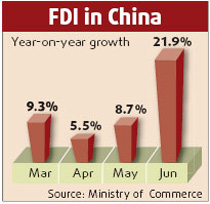China's monthly trade surplus in July dropped US$2.55 billion, or 10.4 percent, from June to US$24.35 billion, the General Administration of Customs said on Friday.
The figure was the second highest monthly level on record.
The country's trade surplus totaled 136.81 billion dollars in the first seven months, the administration said.
July's imports and exports both hit monthly records: imports rose 26.9 percent on July last year to US$83.39 billion while exports were up 34.2 percent to US$107.74 billion.
Imports rose US$7.03 billion from June while exports were up US$4.47 billion.
China's foreign trade for the first seven months totaled US$1.17 trillion, up 24.4 percent from the same period last year.
July's figure met analysts' expectations that the surplus growth would slow this month after domestic companies rushed to export as much as possible to avoid the cut or elimination of export tax rebates meant to suppress overheated export growth.
A report published on Wednesday by the People's Bank of China predicted that the country's trade surplus would remain high while the growth is expected to slow.
Global demand remained strong as the world economy may grow by four percent year on year, the report said.
Meanwhile, accelerating investment in China would take effect in increased export capacity.
Moreover, labor, energy and resources costs were still low, making made-in-China products more competitive, the report said.
Despite the yuan's appreciation, the government still faced difficulty in reducing the trade surplus, said Zhang Yansheng, director of the International Economic Research Institute of the National Development and Reform Commission.
The currency appreciation failed to affect foreign trade as expected, Zhang said.
More than 55 percent of China's exports were made by foreign-funded enterprises, which were little affected by the appreciation as 70 to 90 percent of their materials and spare parts were purchased aboard, he said.
Most foreign-funded enterprises were also unaffected by reduced or canceled export rebates measures as they were chiefly in the IT and equipment manufacturing industries rather than steel and textiles, which were covered by export rebates, Zhang said.
To avoid or reduce the impact of appreciation and export rebate measures, large domestic businesses chose to develop new products, raise prices and produce goods unlisted in the rebate-cut measures, he said.
(Xinhua News Agency August 10, 2007)


